Energy Storage Science and Technology
Jiabao SUN1,2( ), Yue LI1,2(
), Yue LI1,2( ), Hanghang XU1,2, Rui ZHANG1,2, Xingai WANG1,2, Ning WANG1,2, Haichang ZHANG1,2, Fei DING1,2(
), Hanghang XU1,2, Rui ZHANG1,2, Xingai WANG1,2, Ning WANG1,2, Haichang ZHANG1,2, Fei DING1,2( )
)
Received:2025-06-20
Revised:2025-10-28
Contact:
Yue LI, Fei DING
E-mail:jiabao_sun2019@163.com;liyue@hebut.edu.cn;hilldingfei@163.com
CLC Number:
Jiabao SUN, Yue LI, Hanghang XU, Rui ZHANG, Xingai WANG, Ning WANG, Haichang ZHANG, Fei DING. Recent Advances in Structure Design and Ion Transport Mechanisms of Lithium-Ion Battery Materials under Magnetic Field Regulation[J]. Energy Storage Science and Technology, doi: 10.19799/j.cnki.2095-4239.2025.0568.
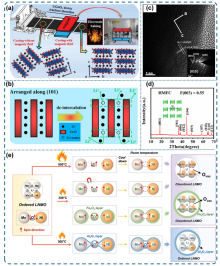
Fig. 2
(a) Schematic diagram of electrode coating process and magnetic field effect under external magnetic field[18]; (b) Deintercalation mechanism of LCO arranged along (010)[18]; (c) High-resolution transition electron microscopy (HRTEM) images of LFP monocrystalline platelets (LFP-P)[28]; (d) X-ray powder diffractometer (XRD) pattern for the horizontal magnetic field–oriented NCM622 cathode (HMFC)[31]; (e) Schematic diagram of the phase transition mechanism for a specific disordered phase[32]"

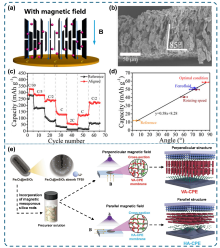
Fig. 3
(a) Magnetic field-induced vertical alignment of graphite flakes [19]; (b) Scanning Electron Microscope (SEM) image of vertical graphite aligned electrode[19]; (c) Performance comparison of vertically aligned graphite electrodes[19]; (d) Evolution of the specific charge at 2C as a function of angle between graphite flakes and current collector[19]; (e) Schematic diagram of the preparation of magnetic field-induced orientation of CPE composite polymer films[37]."

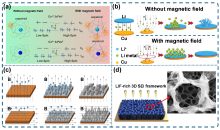
Fig. 4
(a) Magnetic field promotes the electronic transition of Co in Carbon nanofiber/cobalt sulfide (CNF/CoS) electrodes from low spin state to high spin state[17]; (b) Schematic diagram of the suppression of lithium dendrite growth by the MHD effect[20]; (c) Schematic diagram of the mechanism of lithium dendrite growth suppression by magnetic fields in different directions[21]; (d) Toroidal magnetic field induced a LiF-rich 3D SEI framework[47]"

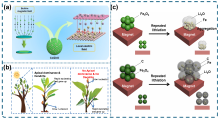
Fig. 6
(a) A schematic diagram of the ion distribution regulation by Co/ZnO magnetic current collector[55]; (b) Schematic illustration of the regulation of Li deep plating by CC@CoF2/C is analogous to the removal of “apical dominance” in plants[56]; (c) A schematic diagram of the restriction of Fe nanoparticles aggregation in a strong magnetic environment by Ni/Fe3O4@C NTAs anode[57]"

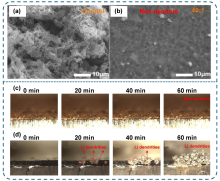
Fig. 7
Morphologies of lithium anode after CE test at a current density of 1.0 mA/cm2: (a) bare Cu, (b) magnetic SEI (PVDF@γ-Fe2O3) with content of magnetic particles of 40 :1[58]; In-situ optical microscopy images of Li deposition on (c) Co-spc-COP and (d) bare Li versus prolonged discharging time at 3 mA/cm2[59]"

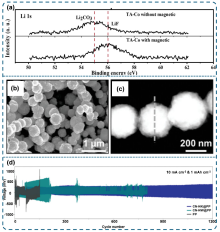
Fig. 8
(a) X-ray photoelectron spectroscopy (XPS) spectra of lithium anode after cycling with/without magnetic field[60]; (b) SEM images of CN-NK[61]; (c) Scanning transmission electron microscopy (STEM) images of CN-NK[61]; (d) The voltage profiles of symmetric cells at 10 mA/cm2 and 1 mAh/cm2[61]"

Table 1
The mechanism of intrinsic magnetic field regulation"
| 路径类型 | 代表材料/结构 | 主要作用机制 | 关键性能指标提升 | 参考文献 |
|---|---|---|---|---|
| 电极材料 | Fe2O3/NC、Li3(V1-xFex)2(PO4)3 | 及时性与持续性特征磁响应、磁致伸缩效应 | 首圈容量+14%,长循环稳定性增强、高磁性含量组能量密度与功率密度协同增强 | [ |
| 集流体 | MOF-74/Ni、Co/ZnO、CoF2 | 调控Li⁺沉积分布,构建平衡电场 | 可达10000 h稳定循环 | [ |
| 界面结构 | γ-Fe2O3,Co-spc-COP | 优化SEI组成与应力分布 | 循环寿命提升至4000~6600 h | [ |
| 隔膜设计 | TA-Co/PP,CN-NK | 增强离子迁移选择性,构建局域三维MHD环境 | 锂枝晶抑制,界面稳定性提升 | [ |
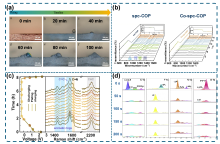
Fig. 9
(a) Li dendrite growth morphology at 10 mA/cm2current density under an external magnetic field[49]; (b) In-situ FT-IR transmittance spectra of spc-COP and Co-spc-COP on charging/discharging process of symmetric cells[59]; (c) In-situ Raman spectra and the corresponding voltage-time profiles in asymmetric cells based on Li@Co-spc-COP[59]; (d) In-situ XPS etching tests for C, F, N, and O elements and element content distribution[47];"

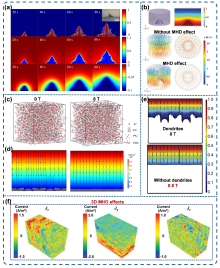
Fig. 10
(a) Phase-field simulation of the evolution of Li dendrite structure: the phase field, the Li+ concentration field, and electric potential field from top to bottom[49]; (b) Simulation results of the different trajectory of Li+ during deposition process without or within magnetic field. The right scale represents the timeline[20]; (c) Boxplot snapshots of the electrolyte from molecular dynamics simulations at 0 and 8 T[48]; (d) COMSOL simulations of Li deposition at 0 and 8 T[48]; (e) the cLi distribution and morphology evolution for the control case and the battery under 0.8 T in COMSOL simulation[46]; (f) The distributions of X-, Y-, and Z- current densities(Jx, Jy, and Jz ) distributions in the electrochemical chamber with the 3D magnetic field[61]"

| [1] | FARGHALI M, OSMAN A I, MOHAMED I M A, et al. Strategies to save energy in the context of the energy crisis: a review [J]. Environmental Chemistry Letters, 2023, 21(4): 1-37. DOI: 10.1007/s10311-023-01591-5 |
| [2] | GUTSCH M, LEKER J. Global warming potential of lithium-ion battery energy storage systems: A review [J]. Journal of Energy Storage, 2022, 52(Part C): 105030. DOI: 10.1016/j.est.2022.105030 |
| [3] | YE J, DIMITRATOS N, ROSSI L M, et al. Hydrogenation of CO2 for sustainable fuel and chemical production [J]. Science, 2025, 387(6737): eadn9388. DOI: 10.1126/science.adn9388 |
| [4] | ENG A Y S, SONI C B, LUM Y, et al. Theory-guided experimental design in battery materials research [J]. Science Advances, 2022, 8(19): 1-17. DOI: 10.1126/sciadv.abm2422 |
| [5] | LIU K, LIU Y, LIN D, et al. Materials for lithium-ion battery safety [J]. Science Advances, 2018, 4(6): eaas9820. DOI: 10.1126/sciadv.aas9820 |
| [6] | LU G, NAI J, LUAN D, et al. Surface engineering toward stable lithium metal anodes [J]. Science Advances, 2023, 9(14): eadf1550. DOI: 10.1126/sciadv.adf1550 |
| [7] | ATTIA P M, MOCH E, HERRING P K. Challenges and opportunities for high-quality battery production at scale [J]. Nature Communications, 2025, 16(1): 611-625. DOI: 10.1038/s41467-025-55861-7 |
| [8] | GUPTA A, MANTHIRAM A. Designing advanced lithium-based batteries for low-temperature conditions [J]. Advanced Energy Materials, 2020, 10(38): 2001972. DOI: 10.1002/aenm.202001972 |
| [9] | WEISS M, RUESS R, KASNATSCHEEW J, et al. Fast charging of lithium-ion batteries: a review of materials aspects [J]. Advanced Energy Materials, 2021, 11(33): 1-37. DOI: 10.1002/aenm.202101126 |
| [10] | CHEN Y, KANG Y, ZHAO Y, et al. A review of lithium-ion battery safety concerns: the issues, strategies, and testing standards [J]. Journal of Energy Chemistry, 2021, 59(8): 83-99. DOI: 10.1016/j.jechem.2020.10.017 |
| [11] | LI Y, ZHANG H, ZHANG R, et al. Lithiophilic seeds and rigid arrays synergistic induced dendrite-free and stable Li anode towards long-life lithium-oxygen batteries [J]. Journal of Energy Chemistry, 2022, 73(10): 268-276. DOI: 10.1016/j.jechem.2022.06.021 |
| [12] | ZHANG X, JU Z, ZHU Y, et al. Multiscale understanding and architecture design of high energy/power lithium-ion battery electrodes [J]. Advanced Energy Materials, 2020, 11(2): 2000808. DOI: 10.1002/aenm.202000808 |
| [13] | WANG Y, WANG N, SHI C, et al. Multi-dimensional hierarchical structure enable sheet-like network li plating with efficient space utilization for advanced lithium metal anodes [J]. Applied Surface Science, 2025, 704: 163374. DOI: 10.1016/j.apsusc.2025.163374 |
| [14] | ZHANG R, CHEN B, MA Y, et al. Armoring lithium metal anode with soft–rigid gradient interphase toward high-capacity and long-life all-solid-state battery [J]. Green Energy & Environment, 2024, 9(8): 1279-1289. DOI: 10.1016/j.gee.2023.02.006 |
| [15] | BOLLOJU S, VANGAPALLY N, ELIAS Y, et al. Electrolyte additives for Li-ion batteries: classification by elements [J]. Progress in Materials Science, 2025, 147(0). DOI: 10.1016/j.pmatsci.2024.101349 |
| [16] | 陈秉乾, 王稼军. 电磁学.第2版 [M]. 北京: 北京大学出版社, 2012: 233 |
| CHEN B G, WANG J J. Electromagnetism. 2nd ed [M], Beijing: Peking University Press, 2012: 233 | |
| [17] | ZHANG C Y, ZHANG C, SUN G W, et al. Spin effect to promote reaction kinetics and overall performance of lithium-sulfur batteries under external magnetic field [J]. Angewandte Chemie, 2022, 134(49): e202211570. DOI: 10.1002/ange.202211570 |
| [18] | ZHANG W, GAO J, HUANG Y, et al. Utilizing magnetic-field modulation to efficiently improve the performance of LiCoO2||graphite pouch full batteries [J]. Advanced Functional Materials, 2023, 33(47): 2306354. DOI: 10.1002/adfm.202306354 |
| [19] | ZHANG L, ZENG M, WU D, et al. Magnetic field regulating the graphite electrode for excellent lithium-ion batteries performance [J]. ACS Sustainable Chemistry & Engineering, 2019, 7(6): 6152-6160. DOI: 10.1021/acssuschemeng.8b06358 |
| [20] | SHEN K, WANG Z, BI X, et al. Magnetic field-suppressed lithium dendrite growth for stable lithium-metal batteries [J]. Advanced Energy Materials, 2019, 9(20): 1900260. DOI: 10.1002/aenm.201900260 |
| [21] | HUANG Y, WU X, NIE L, et al. Mechanism of lithium electrodeposition in a magnetic field [J]. Solid State Ionics, 2020, 345(0): 115171. DOI: 10.1016/j.ssi.2019.115171 |
| [22] | KUANG Y, CHEN C, KIRSCH D, et al. Thick electrode batteries: principles, opportunities, and challenges [J]. Advanced Energy Materials, 2019, 9(33): 1901457. DOI: 10.1002/aenm.201901457 |
| [23] | WANG X, YU A, JIANG T, et al. Accelerating Li-ion diffusion in LiFePO4 by polyanion lattice engineering [J]. Advanced Materials, 2024, 36(47): e2410482. DOI: 10.1002/adma.202410482 |
| [24] | HONG L, LI L, CHEN-WIEGART Y K, et al. Two-dimensional lithium diffusion behavior and probable hybrid phase transformation kinetics in olivine lithium iron phosphate [J]. Nature Communications, 2017, 8(1): 1194-1207. DOI: 10.1038/s41467-017-01315-8 |
| [25] | HONG L, YANG K, TANG M. A mechanism of defect-enhanced phase transformation kinetics in lithium iron phosphate olivine [J]. npj Computational Materials, 2019, 5(1): 118-127. DOI: 10.1038/s41524-019-0255-3 |
| [26] | CAO Z, YAO X, PARK S, et al. Enhancing cathode composites with conductive alignment synergy for solid-state batteries [J]. Science Advances, 2025, 11(1): eadr4292. DOI: 10.1126/sciadv.adr4292 |
| [27] | GUO Y, JIANG Y, ZHANG Q, et al. Directional LiFePO4 cathode structure by freeze tape casting to improve lithium ion diffusion kinetics [J]. Journal of Power Sources, 2021, 506(15): 230052. DOI: 10.1016/j.jpowsour.2021.230052 |
| [28] | ZHOU J, ZHANG D, SUN G, et al. B-axis oriented alignment of LiFePO4 monocrystalline platelets by magnetic orientation for a high-performance lithium-ion battery [J]. Solid State Ionics, 2019, 338(0): 96-102. DOI: 10.1016/j.ssi.2019.05.002 |
| [29] | KIM C, YANG Y, HA D, et al. Crystal alignment of a LiFePO4 cathode material for lithium ion batteries using its magnetic properties [J]. Rsc Advances, 2019, 9(55): 31936-31942. DOI: 10.1039/c9ra05284d |
| [30] | KIM C, YANG Y, LOPEZ D H. Crystal alignment technology of electrode material for enhancing electrochemical performance in lithium ion battery [J]. Journal of the Electrochemical Society, 2021, 168(4): 040502. DOI: 10.1149/1945-7111/abf17c |
| [31] | GAO D, YANG J, ZHANG D, et al. An effective strategy to enhance the electrochemical performance of LiNi0.6Mn0.2Co0.2O2: Optimizing a Li diffusion pathway via magnetic alignment of single-crystal cathode material under an ordinary 0.4 T magnetic field [J]. Ceramics International, 2022, 48(21): 31598-31605. DOI: 10.1016/j.ceramint.2022.07.081 |
| [32] | SUN S, LI X, ZHANG C, et al. Magnetic field-induced disordered phase of spinel oxides for high battery performance [J]. Advanced Materials, 2024, 36(35): e2405876. DOI: 10.1002/adma.202405876 |
| [33] | CHEMELEWSKI K R, LEE E-S, LI W, et al. Factors influencing the electrochemical properties of high-voltage spinel cathodes: relative impact of morphology and cation ordering [J]. Chemistry of Materials, 2013, 25(14): 2890-2897. DOI: 10.1021/cm401496k |
| [34] | ZHANG L, ZENG M, LIU Z, et al. Aligned Ti3C2Tx Electrodes induced by magnetic field for high-performance lithium-ion storage [J]. ACS Applied Energy Materials, 2021, 4(6): 5590-5598. DOI: 10.1021/acsaem.1c00361 |
| [35] | YANG K, JIANG Y, HUANG C. Fabrication of vertically aligned porous graphite anodes via magnetic field-assisted freezing casting for high-performance lithium-ion batteries [J]. International Journal of Electrochemical Science, 2023, 18(11): 100348. DOI: 10.1016/j.ijoes.2023.100348 |
| [36] | GAUDILLERE C, SERRA J M. Freeze-casting: Fabrication of highly porous and hierarchical ceramic supports for energy applications [J]. Boletín de la Sociedad Española de Cerámica y Vidrio, 2016, 55(2): 45-54. DOI: 10.1016/j.bsecv.2016.02.002 |
| [37] | DENG T, HAN Q, LIU J, et al. Vertically aligned hollow mesoporous silica rods enabling composite polymer electrolytes with fast ionic conduction for lithium metal batteries [J]. Advanced Functional Materials, 2023, 34(16): e2311952. DOI: 10.1002/adfm.202311952 |
| [38] | YAN C, XU R, XIAO Y, et al. Toward critical electrode/electrolyte interfaces in rechargeable batteries [J]. Advanced Functional Materials, 2020, 30(23). DOI: 10.1002/adfm.201909887 |
| [39] | LI B, CHAO Y, LI M, et al. A review of solid electrolyte interphase (SEI) and dendrite formation in lithium batteries [J]. Electrochemical Energy Reviews, 2023, 6(1). DOI: 10.1007/s41918-022-00147-5 |
| [40] | KONDO Y, ABE T, YAMADA Y. Kinetics of interfacial ion transfer in lithium-ion batteries: Mechanism understanding and improvement strategies [J]. ACS Applied Materials & Interfaces, 2022, 14(20): 22706-22718. DOI: 10.1021/acsami.1c21683 |
| [41] | PERVEZ S A, CAMBAZ M A, THANGADURAI V, et al. Interface in solid-state lithium battery: challenges, progress, and outlook [J]. ACS Applied Materials & Interfaces, 2019, 11(25): 22029-22050. DOI: 10.1021/acsami.9b02675 |
| [42] | PIAO Z, GAO R, LIU Y, et al. A review on regulating Li+ solvation structures in carbonate electrolytes for lithium metal batteries [J]. Advanced Materials, 2023, 15. DOI: 10.1002/adma.202206009 |
| [43] | ADENUSI H, CHASS G A, PASSERINI S, et al. Lithium batteries and the solid electrolyte interphase (SEI)-progress and outlook [J]. Advanced Energy Materials, 2023, 13(10). DOI: 10.1002/aenm.202203307 |
| [44] | 阮观强, 华菁, 胡星, 等. 磁场效应对锂离子电池性能的影响 [J]. 储能科学与技术, 2022, 11(1): 265-274 |
| RUAN G Q, HUA J, HU X, et al. Effect of magnetic field on the lithium-ion battery performance [J]. Energy Storage Science and Technology, 2022, 11(1): 265-274 | |
| [45] | RUAN G, FU X, HU X, et al. Influence of magnetic field on charge and discharge performance of electric vehicle power battery [J]. Proceedings of the Institution of Mechanical Engineers, Part D: Journal of Automobile Engineering, 2023, 239(2): 866-876. DOI: 10.1177/09544070231207915 |
| [46] | CHEN Y, DOU X, WANG K, et al. Magnetically enhancing diffusion for dendrite-free and long-term stable lithium metal anodes [J]. Green Energy & Environment, 2022, 7(5): 965-974. DOI: 10.1016/j.gee.2020.12.014 |
| [47] | LI Y, XIAO M, SHEN C, et al. Three-dimensional SEI framework induced by ion regulation in toroidal magnetic field for lithium metal battery [J]. Cell Reports Physical Science, 2022, 3(10). DOI: 10.1016/j.xcrp.2022.101080 |
| [48] | GAO Y, QIAO F, LI N, et al. Full-chain enhanced ion transport toward stable lithium metal anodes [J]. Journal of Energy Chemistry, 2023, 79(4): 390-397. DOI: 10.1016/j.jechem.2023.01.030 |
| [49] | WANG S, DENG Q, GU J, et al. In-situ observation of lithium dendrite growth regulated by the external magnetic field [J]. Journal of Energy Storage, 2025, 115: 116004. DOI: 10.1016/j.est.2025.116004 |
| [50] | YU L, WANG J, XU Z J. A perspective on the behavior of lithium anodes under a magnetic field [J]. Small Structures, 2020, 2(1): 2000043. DOI: 10.1002/sstr.202000043 |
| [51] | MAO Y, ZHU T, HAO X, et al. Growth mechanism for dendrite-free lithium regulated deposition [J]. Journal of Energy Storage, 2024, 77: 109904. DOI: 10.1016/j.est.2023.109904 |
| [52] | GANGULY D, V S A, GHOSH A, et al. Magnetic field assisted high capacity durable Li-ion battery using magnetic α-Fe2O3 nanoparticles decorated expired drug derived N-doped carbon anode [J]. Scientific Reports, 2020, 10(1): 9945-9955. DOI: 10.1038/s41598-020-67042-1 |
| [53] | LEE Y T, CHEN Y T, CHENG J Y, et al. Investigation of lithium-ion battery performance utilizing magnetic controllable superionic conductor Li3(V1-xFex)2(PO4)3/C (x = 0.05 and 0.10) [J]. ACS Omega, 2024, 9(26): 28283-28292. DOI: 10.1021/acsomega.4c01757 |
| [54] | CHEN H, HU J, LI H, et al. 3D Magnetic metal-organic frameworks current collectors accelerate the lithium-ion diffusion rate for superlong cyclic lithium metal anode [J]. Small, 2024, 20(9): e2307598. DOI: 10.1002/smll.202307598 |
| [55] | CAO W, WU Z, YANG Y, et al. Field-assisted regulation induced by cobalt-doped ZnO for dendrite-free lithium metal anodes [J]. Chemistry – A European Journal, 2024, 30(2): e202302867. DOI: 10.1002/chem.202302867 |
| [56] | LIU M, MA J, ZHANG X, et al. Regulating of lithium-ion dynamic trajectory by ferromagnetic CoF2 to achieve ultra stable deep lithium deposition over 10000 h [J]. Advanced Functional Materials, 2024, 35(10): 2416527. DOI: 10.1002/adfm.202416527 |
| [57] | XIAO S, ZHANG Y, ZHOU X, et al. 3D spatially-confined magnetic anodes towards advanced lithium ion batteries [J]. Journal of Alloys and Compounds, 2023, 967: 171827. DOI: 10.1016/j.jallcom.2023.171827 |
| [58] | CHEN Y, LIU H, LIU L, et al. Construction of a magnetic interphase for stable cycling of lithium metal batteries [J]. Batteries & Supercaps, 2023, 7(1): e202300389. DOI: 10.1002/batt.202300389 |
| [59] | LU X M, CAO Y, SUN Y, et al. Sp-carbon-conjugated organic polymer as multifunctional interfacial layers for ultra-long dendrite-free lithium metal batteries [J]. Angewandte Chemie International Edition, 2024, 63(15): e202320259. DOI: 10.1002/anie.202320259 |
| [60] | ZHANG J, DU Z, WANG Y, et al. Magnetic field-driven ion selectivity boosts LiF-rich SEI formation for enhanced lithium metal battery performance across temperatures [J]. ACS Applied Materials & Interfaces, 2025, 17(12): 18329-18338. DOI: 10.1021/acsami.4c21968 |
| [61] | BAE M, KANG M, PIAO Y. Efficient charge redistribution achieved by 3D micromagnetic fields for dendrite-free lithium metal batteries [J]. Advanced Functional Materials, 2025: e2421952. DOI: 10.1002/adfm.202421952 |
| [1] | Liyue HU, Wei HUANG, Yun ZHOU, Yingqiang ZHOU, Changzheng SHAO, Ke WANG. Fuzzy reasoning-based evaluation of the thermal diffusion probability of lithium-ion battery modules for energy storage systems [J]. Energy Storage Science and Technology, 2025, 14(7): 2662-2674. |
| [2] | Feng XIONG, Depeng KONG, Ping PING, Yue ZHANG, Xiantong REN, Yao LV. Study on the characteristics of electrothermal coupling-induced thermal runaway of ternary lithium-ion batteries [J]. Energy Storage Science and Technology, 2025, 14(7): 2752-2760. |
| [3] | Wenyuan WENG, Bin SHEN, Jiangong ZHU, Yang WANG, Huapeng LU, Wuliyasu HE, Haonan LIU, Haifeng DAI, Xuezhe WEI. Detecting hazardous lithium plating on anodes of lithium-ion batteries—A review of in situ methods [J]. Energy Storage Science and Technology, 2025, 14(7): 2575-2589. |
| [4] | Zijing ZHANG, Beibei YUAN, Hong LI, Ying GAO. Thermal runaway gas detection and early warning of lithium-ion batteries [J]. Energy Storage Science and Technology, 2025, 14(7): 2820-2832. |
| [5] | Jiahui LIU, Weixiang BIAN, Dawei LI. In situ measurement and analysis of the electromechanical coupling performance of composite graphite electrodes in lithium batteries [J]. Energy Storage Science and Technology, 2025, 14(6): 2240-2247. |
| [6] | Chunling WU, Liding WANG, Yong LU, Limin GENG, Hao CHEN, Jinhao MENG. Lithium-ion batteries SOH estimation based on gaussian processed regression optimized by egret swarm optimization [J]. Energy Storage Science and Technology, 2025, 14(6): 2498-2511. |
| [7] | Gongrui WANG, Anping ZHANG, Xuanxuan REN, Mingzhe YANG, Yuning HAN, Zhongshuai WU. High-voltage lithium cobalt oxide cathode: Key challenges, modification strategies and future prospectives [J]. Energy Storage Science and Technology, 2025, 14(6): 2278-2319. |
| [8] | Haiyang ZHOU, Zhendong ZHANG, Lei SHENG, Zehua ZHU, Xiaojun ZHANG, Chunfeng ZHANG. Simulation of immersion thermal performance regulation and thermal safety experimental study for energy storage lithium batteries [J]. Energy Storage Science and Technology, 2025, 14(5): 1866-1874. |
| [9] | Zhoulan ZENG, Lei SHANG, Zhijin HU, Zongfan WANG, Xiaochao XIN, Ying LIU. Li5FeO4@C high capacity prelithium cathode materials for lithium-ion batteries [J]. Energy Storage Science and Technology, 2025, 14(5): 1875-1883. |
| [10] | Ziming MO, Zongxin RAO, Jianfei YANG, Menghao YANG, Liming CAI. Construction and characteristic analysis of key parameters in a gas-thermal model for thermal runaway in lithium-ion battery based on overcharge [J]. Energy Storage Science and Technology, 2025, 14(5): 1784-1796. |
| [11] | Lei PENG, Zhaopeng NI, Yue YU, Fupeng SUN, Xiulong XIA, Peng ZHANG, Sibo SUN. Experimental study on NCM lithium-ion battery electric vehicle fire caused by overcharging [J]. Energy Storage Science and Technology, 2025, 14(4): 1484-1495. |
| [12] | Jiangwei SHEN, Yixin SHE, Xing SHU, Yonggang LIU, Fuxing WEI, Xuelei XIA, Zheng CHEN. State of health estimation for lithium batteries based on short-term random charging data and optimized convolutional neural network [J]. Energy Storage Science and Technology, 2025, 14(4): 1585-1595. |
| [13] | Ruihao LIU, Xiaole MA, Yuxuan ZHANG, Yueying ZHU, Shiqiang LIU, Guangli BAI. Influencing factors of thermal property parameter testing of lithium-ion batteries based on accelerating rate calorimeters [J]. Energy Storage Science and Technology, 2025, 14(4): 1596-1602. |
| [14] | Zuolin DONG, Jinyan SONG, Zidi MENG. Lithium-ion battery life prediction based on mode decomposition and deep learning [J]. Energy Storage Science and Technology, 2025, 14(4): 1645-1653. |
| [15] | Zhiming CHEN, Aimin CHU, Ziyu ZHOU, Yuping Zhao, Youming CHEN. Preparation and performance of Li-rich cathode material by carbon-containing droplet combustion [J]. Energy Storage Science and Technology, 2025, 14(4): 1362-1368. |
| Viewed | ||||||
|
Full text |
|
|||||
|
Abstract |
|
|||||
